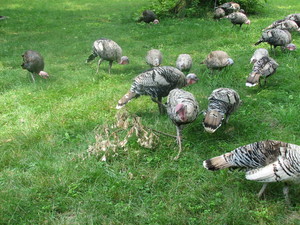
The Call Again Farm Journal
03 Apr Fri 2009
Customers and Candling
What an exciting afternoon for my business yesterday! I sold two dozen eggs to the woman we split our winter CSA share from Thorpe's farm. Also, a woman who'd wanted to come to my little farm and get some honey around noon yesterday couldn't, because the doctor's office asked her to bring her father in for an appointment early. However, it turned out we both had to go to Thorpe's in the evening, so we met there! She was very friendly, bought lots of honey, and had read my blog! She's the first person I ever met who'd read my blog, so I was rather excited. I was even more excited to find out that she'd still like to come to my farm and see my animals, because I love to show them off. However, I realized I never got her phone number or email address (she'd called me), so I'll just have to hope that she'll remember to call sometime again.
This morning, Dianna and I candled the turkey eggs in the incubator. For those of you not familiar with incubation, candling is a process of deciding whether or not eggs in the incubator are fertilized and developing. To candle, you hold an egg, big end up, next to a bright light in a dark room. An unfertilized egg will be see-through, but a fertilized egg will have a dark splotch in the middle after several days of incubation (although I've found this very hard to discern.) As incubation continues, candling gets easier and easier. When candling eggs at sixteen days or so, the egg's contents look completely black, with the exception of the air cell. (The air cell is exactly what it sounds like, an area at the top of the cell that contains oxygen.)
We were supposed to candle yesterday, seven days after we put the eggs in the incubator, but were very busy and never found time to do it. We own a wonderful book, called The New Incubation Book, that has very comprehensive information on incubation and many pictures of what eggs should look like in various phases of incubation when candled, including seventh day. Following the picture in the book, we were looking for the dark blob in the middle to be bigger, there to be the beginnings of an air cell visible, and perhaps the appearance of a few veins. Seventh day (or, in this case, eighth day) candling is a lot easier than third day candling, which I've given up on altogether, but still it's really hard to be sure.
We ended up not getting rid of a single egg, but we marked the most questionable ones with a question mark in pencil on their shell so if they still look bad at twelfth day candling we know it's probably best to get rid of them. The reason you candle and dispose of the eggs that aren't developing (or the ones that started to develop and then, for whatever reason, ceased to) is because bacteria can grow in such eggs and then hurt the perfectly good embryos in other eggs.
With regards to our broody turkey hen, we've decided to just let her incubate the eggs she's collected. Some of them are undoubtedly very old, and have sat outdoors through some very cold weather. Therefor, we're not going to count on her hatching a single poult (baby turkey), but if she does, we'll just count it as a bonus. I hope she does, though, because there's nothing happier than a little family of a mama hen and her babies. I love that heritage breeds have this trait (broodiness), and would never consider keeping a breed that has broodiness bred out of them.
